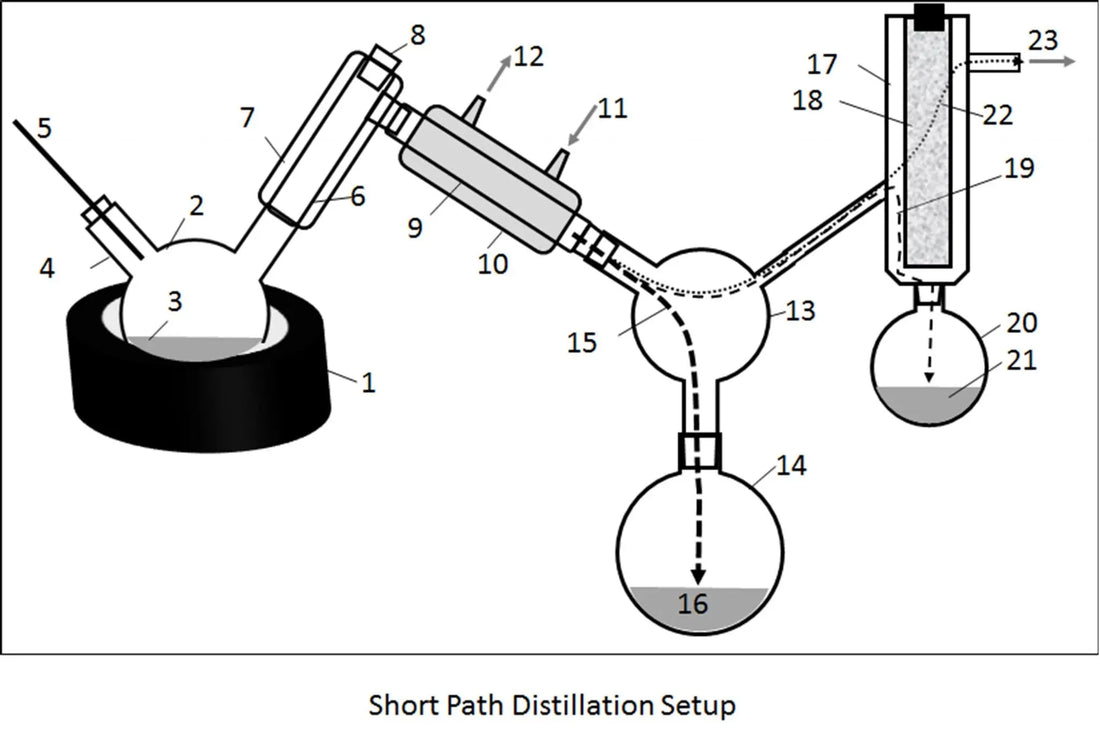
Unlocking the Power of Cannabis Distillation: A Beginner's Guide
Share
Unlocking the Power of Cannabis Distillation
Introduction: As the cannabis industry continues to evolve, innovative techniques like distillation are revolutionizing the way we extract and consume cannabinoids. Whether you're a seasoned enthusiast or just diving into the world of cannabis, understanding distillation can unlock a plethora of possibilities. In this beginner's guide, we'll explore the basics of cannabis distillation, its benefits, and how it's shaping the future of the industry.
What is Cannabis Distillation? Cannabis distillation is a process used to separate and refine cannabinoids like THC and CBD from the plant material. By utilizing the principles of heat, vaporization, and condensation, distillation allows for the extraction of pure cannabinoids with higher potency and purity compared to other methods.
The Distillation Process:
- Extraction: The process begins with extracting cannabinoids from the cannabis plant using solvents like ethanol or CO2.
- Purification: The crude extract is then subjected to distillation, where it is heated to vaporize cannabinoids while leaving behind impurities.
- Fractional Distillation: Through fractional distillation, cannabinoids are separated based on their boiling points, allowing for precise control over the purification process.
- Collection: The purified cannabinoids are condensed back into liquid form and collected for further processing or consumption.
Benefits of Cannabis Distillation:
- Purity: Distillation produces highly pure cannabinoids, free from plant material and other contaminants.
- Potency: By removing impurities, distillation increases the potency of cannabinoids, leading to more potent products.
- Versatility: Distillation allows for the isolation of specific cannabinoids, enabling the creation of tailored products with targeted effects.
- Consistency: With precise control over the purification process, distillation ensures consistency in cannabinoid content from batch to batch.
Applications of Distillation:
- Vape Cartridges: Distillates are commonly used in disposable vape cartridges, providing a convenient and discreet way to consume cannabinoids.
- Edibles and Topicals: Purified cannabinoids can be incorporated into edibles, tinctures, and topicals, offering a consistent and potent experience.
- Medicinal Use: Distillation allows for the isolation of therapeutic cannabinoids, making it a valuable tool for medical cannabis patients.
Conclusion: As the cannabis industry continues to innovate, distillation stands out as a powerful technique for unlocking the full potential of cannabinoids. Whether you're a consumer looking for potent and consistent products or a producer striving for excellence, understanding the principles of distillation is essential. With its ability to produce highly pure and potent cannabinoids, distillation is shaping the future of cannabis consumption and cultivation.
Ready to explore the world of cannabis distillation? Visit Viking Lab Supply for premium distillation equipment and start your journey today!
Cannabis distillation has quickly become a cornerstone of the cannabis extraction industry because it produces some of the purest and most efficient extracts available. Whether you’re a cannabis enthusiast or a budding entrepreneur, understanding the ins and outs of cannabis distillation can give you an edge in achieving high-quality results.
The process of distillation involves isolating cannabinoids and terpenes from the raw cannabis plant material through a series of heating and cooling cycles. This not only enhances the purity but also elevates the potency of the final product. Cannabis distillation generally includes steps such as winterization, decarboxylation, and the actual distillation process. Each of these plays a crucial role in removing impurities and maximizing the beneficial components of the cannabis plant.
One of the primary benefits of cannabis distillation is that it allows for the creation of highly refined cannabis oils, which can be used in a variety of applications, including edibles, topicals, and vape products. Distillates are prized for their versatility, long shelf life, and the fact that they can be easily infused into other products. But mastering this technique requires not just the right equipment but also a deep understanding of the underlying chemical processes.
To get started with cannabis distillation, you need specialized equipment such as a distillation apparatus, vacuum pumps, and heating mantles. While the initial investment can be significant, the potential return in the form of high-quality, market-ready products can justify the cost. Additionally, adhering to best practices and safety protocols during the distillation process is pivotal for achieving an optimal end product and ensuring the safety of all personnel involved.
The cannabis distillation process begins with winterization, which involves dissolving the cannabis extract in ethanol and then freezing it to remove fats and waxes. After winterization, the extract goes through decarboxylation to activate the cannabinoids by heating the material, converting THCA into THC. The final and most critical step is the distillation itself, where the cannabinoids are separated from other plant materials through controlled heating and condensation.
Understanding the various types of distillation methods, such as short-path and wiped film distillation, is fundamental. Short-path distillation is often preferred for its simplicity and efficiency, especially for small-batch operations. On the other hand, wiped film distillation is ideal for larger-scale productions because it allows for continuous processing and can handle higher throughputs.
For those new to cannabis distillation, it’s essential to start with a comprehensive understanding of cannabinoid chemistry and the specific properties of the cannabis strain being used. Each strain has a unique profile of cannabinoids and terpenes that can influence the distillation outcome. Experimentation and meticulous record-keeping can help in refining techniques and consistently achieving superior results.
Quality control is another critical aspect. Ensuring that the distillate meets industry standards for purity and potency is vital for gaining consumer trust and complying with regulatory requirements. Routine testing for contaminants, such as residual solvents, pesticides, and heavy metals, is a non-negotiable part of the process.
In conclusion, mastering cannabis distillation opens up a world of possibilities in creating high-quality cannabis products. From understanding the technicalities of the process to making informed choices about equipment and maintaining rigorous quality control, each step contributes to the final product's excellence. Whether you’re an enthusiast seeking to elevate your personal use or a professional aiming to tap into the burgeoning cannabis market, this beginner's guide to cannabis distillation equips you with the knowledge to succeed.